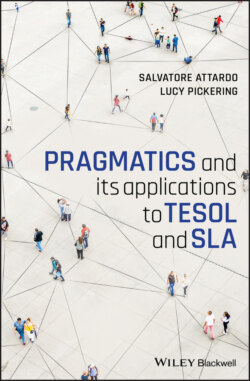Читать книгу Pragmatics and its Applications to TESOL and SLA - Salvatore Attardo - Страница 25
2.2 What Do Learners Typically Transfer from Their L1?
ОглавлениеTo some extent the answer to this is, of course, any linguistic action that is performed in a social context and that the learner may consciously or unconsciously transfer due to their lack of knowledge of the L2. However, research allows us to be more specific in terms of general features of pragmatic development. For example, beginning learners will be limited in terms of both their pragmalinguistic and sociopragmatic strategies. Their grammatical competence is simply not yet strong enough to provide them with the range of linguistic structures that they need to express their intentions. Examples such as Me no want or literal translations from the L1 may be the result of underdeveloped grammatical competence. Sociopragmatic strategies are also more likely to be directly transferred. Istifçi (2009) found that intermediate level learners of English from Turkey included the notion of blame in their English apology structure. For example, by shifting blame onto the hearer (e.g., why didn’t you remind me?). Although this is a sociocultural norm in Turkish, it is not common in English apology structures. She further found that learners at an advanced proficiency in English no longer transferred this aspect of apology structure. Thus, proficiency is one driver of certain kinds of transfer.
There are other possible root causes for transfer effects. Olshtain (1983) proposes that learners may be more or less likely to transfer L1 sociocultural rules depending on their perception of “language specificity or language universality” (p. 233). In other words, given the same situation in both the L1 and L2, in this case different apology situations, some learners believe that the choice to apologize should be based on their understanding of only the L2 pragmatics (i.e., a language specific approach). However, other learners focus only on the situation and believe that an apology is always/never warranted regardless of the particular language in question (i.e., a universal approach). Olshtain reports her results regarding apologies in Hebrew by Russian and English learners by language group and suggests that overall, English learners of Hebrew approached apologies in a language specific way while Russian learners had a more universal approach.
Another possible cause of transfer from the L1 is resistance to the pragmatic norms or the expression of them in the L2 (Iwasaki, 2011; Trosborg, 2010). Siegal (1994, 1996) explores this issue with female learners of Japanese who lived and worked in Japan. Although these second-language learners “were concerned with being polite and not causing offence,” there was also some resistance to adopting some of the pragmatic norms when they were considered by the learners to be inappropriate. For example, in the words of Karen, a 25-year-old American English professor and Japanese language student, living in Hiroshima, Japan, (1991):
I don’t think I’ve found my Japanese persona yet, who I am when I am speaking Japanese? I was listening to this lady speaking on the telephone in a little squeaky voice (imitates voice) it’s like no I don’t think I can do that, it’s not for me – um – I don’t know.
(Siegal,1996, p. 356)
Dewaele (2008) further develops this idea of appropriateness and suggests that some learners develop a very keen sense of metapragmatic awareness, which they are willing to adapt to while others have a more “ambiguous attitude” toward adopting different language behaviors. As Dewaele notes, the issue of agency in conscious deviation from the target language also complicates the notion of pragmatic failure. The traditional definition of pragmatic failure is “communication breakdown caused by lack of pragmatic competence” (Matsuda, 1999, p. 40; or see Thomas (1983) for a more detailed definition), which seems to assume a lack of knowledge of sociocultural norms. However, this definition does not seem to allow room for full recognition of these kinds of deliberate choices by learners. We will look further at pragmatic failure in Chapter 8.
